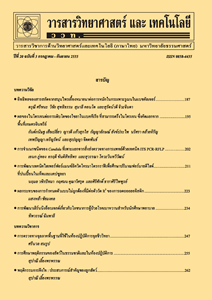การเปรียบเทียบประสิทธิภาพของตัวสถิติทดสอบสำหรับการทดสอบภาวะความเท่ากันของความแปรปรวน
Main Article Content
Abstract
The objectives of this study were to compare the efficiency of six statistics tests: Bartlett’s test, Levene’s test, Brown-Forsythe’s test, O’Brien’s test, Klotz’s test, and Mood’s test, including the recommending the appropriate test statistic by calculate the probability of type I error and power of a test, classification of the population according to normal distribution, left-skewed and leptokurtic kurtosis distribution, left-skewed and platykurtic kurtosis distribution, right-skewed and leptokurtic kurtosis distribution, and right-skewed and platykurtic kurtosis distribution. Study three and four populations, including the sample sizes were equal and unequal. Sample sizes were divided into small, medium, and large size. Defined the difference of the population variance into three levels: low, moderate, and high difference. The significance levels to study were 0.01 and 0.05. The data were simulated by using SAS programming with 1,000 replicates. Results of the research were as follows. When the population was normal distribution, Bartlett’s test was the most appropriate. But when the population was non-normal, Klotz’s Test and Mood’s Test were the most appropriate. If the difference of population variance was moderate to high difference, it was found that almost all test statistics were appropriate. In order to increase the power of a test, should increase the sample size.
Keywords: testing homogeneity of variance; probability of type I error; power of a test
Article Details
References
[2] อนันต์ชัย เขื่อนธรรม, 2539, หลักการวางแผนการทดลอง, มหาวิทยาลัยเกษตรศาสตร์, กรุงเทพฯ.
[3] Gene, V.G. and Hopkins, K.D., 1996, Statistical Methods in Education and Psychology, 3rd Ed., Allyn and Becon, New Jersey.
[4] Conover, W.J., Johnson, M.E. and Johnson, M.M., 1981, A comparative study of tests for homogeneity of variances, with applications to the outer continental shelf bidding data, Technometrics 23: 351-361.
[5] วลัยพร ชื่นธีระวงศ์, 2544, การเปรียบเทียบอำนาจการทดสอบของสถิติทดสอบที่ใช้ทดสอบความเท่ากันของความแปรปรวนของประชากรในกรณีที่การแจกแจงของประชากรไม่เป็นแบบปกติ, วิทยานิพนธ์ปริญญาโท, มหาวิทยาลัยธรรมศาสตร์, ปทุมธานี, 167 น.
[6] สำนักงานสถิติแห่งชาติ, การเลือกใช้ตัวทดสอบสถิติ, แหล่งที่มา : http://service.nso.go.th/nso/nsopublish/know/estat04.pdf, 21 ธันวาคม 2558.
[7] ดวงพร หัชชะวณิช, 2557, การเปรียบเทียบความคลาดเคลื่อนชนิดที่ 1 และอำนาจการทดสอบของสถิติทดสอบความเป็นเอกพันธ์ของความแปรปรวน, ว.วิทยาศาสตร์ลาดกระบัง 23(1): 17-28.
[8] Ramberg, J.S., Tadikamalla, P.R., Dudewicz, E.J. and Mykytka, E.F., 1979, A probability distribution and its uses in fitting data, Technometrics 21: 201-214.
[9] Games, P.A., Winkle, H.J. and Probert, D.A., 1972, Robust tests for homogeneity of variance, Edu. Psychol. Measure. 32: 274-285.
[10] วรางคณา เรียนสุทธิ์, 2559, แผนแบบการทดลอง, ศูนย์หนังสือมหาวิทยาลัยทักษิณ, สงขลา.
[11] O’Brien, R.G., 1981, A simple test for variance effects in experimental design, Phychol. Bull. 89: 570-574.
[12] SAS Help, Chapter 47 The NPAR1WAY Procedure, Available Source: http://www.okstate.edu/sas/v8/saspdf/stat/chap47.pdf, August 31, 2016.
[13] จริยา เสกสรรค์, 2551, ผลกระทบของการฝ่าฝืนข้อกำหนดเบื้องต้นเกี่ยวกับความเป็นเอกภาพของความแปรปรวนต่อความคลาดเคลื่อนประเภทที่ 1 ในการทดสอบความแตกต่างระหว่างประชากรสองกลุ่ม, วิทยานิพนธ์ปริญญาโท, มหาวิทยาลัยเกษตรศาสตร์, กรุงเทพฯ, 109 น.
[14] เยาวภา ไชยศรี, 2542, การเปรียบเทียบประสิทธิภาพของตัวทดสอบสถิติบาร์ตเลต เลอวีน และบราวน์-ฟอร์สิตี สำหรับทดสอบความเท่ากันของความแปรปรวนของประชากร, วิทยานิพนธ์ปริญญาโท, มหาวิทยาลัยเกษตรศาสตร์, กรุงเทพฯ, 145 น.
[15] พรรษณพร จันทร์ดี, 2549, สถิติทดสอบที่มีความแกร่งสำหรับการทดสอบความเท่ากันของความแปรปรวนของประชากร, วิทยานิพนธ์ปริญญาโท, มหาวิทยาลัยเกษตรศาสตร์, กรุงเทพฯ, 89 น.
[16] ศรีวนา ศรีสมบูรณ์, 2553, การเปรียบเทียบอำนาจการทดสอบของสถิติทดสอบสำหรับการทดสอบความเท่ากันของความแปรปรวน, วิทยานิพนธ์ปริญญาโท, มหาวิทยาลัยเกษตรศาสตร์, กรุงเทพฯ, 177 น.
[17] วรางคณา เรียนสุทธิ์, 2560, การเปรียบเทียบประสิทธิภาพของตัวสถิติทดสอบสำหรับการทดสอบภาวะความเท่ากันของความแปรปรวน, รายงานวิจัย, มหาวิทยาลัยทักษิณ, พัทลุง, 146 น.


